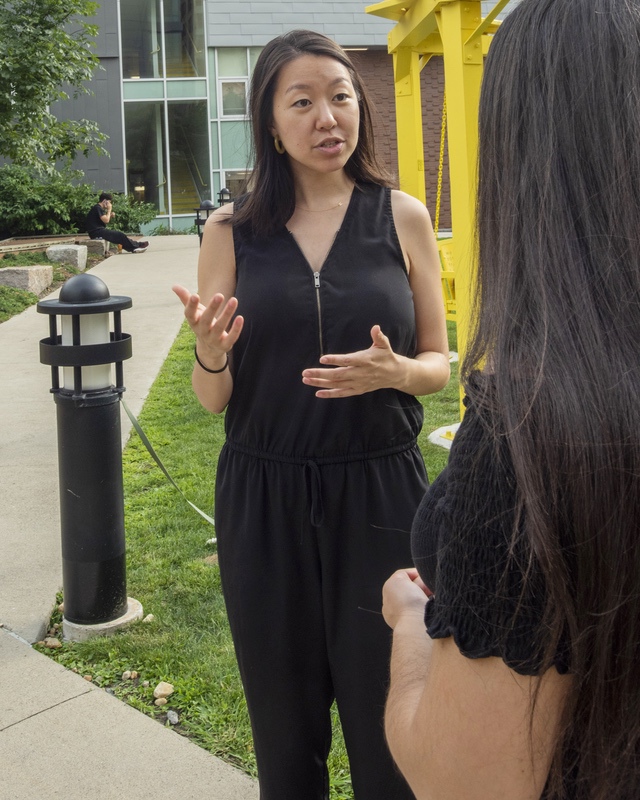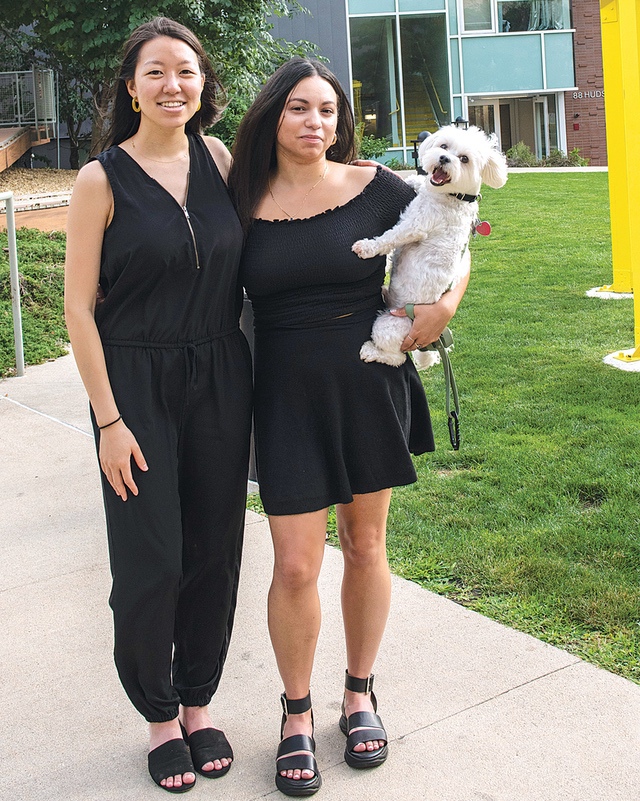HOUSING EQUITY IN ACTION: PUBLIC SPACES IN CHINATOWN
Jeena Chang
Asian Community Development Corporation
PLEASE DESCRIBE THE WORK YOU DO AT ACDC.
In my role, I wear multiple hats. One is arts administrator, another is community organizer and another is urban planner. So, I’m juggling different roles. I work in the community to try to promote self-determination in the neighborhood, so I work with young people and working-class families, particularly those with young children because it’s hard for them to engage in community planning because they’re working multiple jobs, taking care of their children, taking care of their parents. So, the reason “community programs” is in my title is because we really work to engage the folks who are usually missing at the decision-making table.
And so, we design art programs that attract them to the work. Actually, we’re teaching urban planning; we’re just not framing it in that way because it could be a little daunting.
And then we translate these art projects to shape planning design projects in the neighborhood and expand the neighborhood’s cultural footprint. It’s really an anti-gentrification strategy that complements our other work.
Hudson Street used to be the heart of Chinatown before urban renewal.
HOW MANY BUILDINGS ARE THERE ON HUDSON STREET?
We were able to bring back over 140 working-class households, with 51 units of affordable condos at 88 Hudson and condos at 95 affordable rentals.
HOW DID YOU HEAR ABOUT THE PLACE LEADERSHIP NETWORK?
We were involved in the conceptual process before we were applicants. Philip (Barash) put together a sort of think tank with Mass. Cultural Council and others and had an informal huddle to conceptualize what value the program would bring and what the needs are. And I think you nailed it before when you were talking about Hudson Street. Our artist, Gianna Stewart, designed the installation. Gianna was talking with some former residents, one was Cynthia Yee, who grew up on Hudson Street and she described Hudson Street as the front porch of Chinatown. It was a hub of activity with kids playing in the street, community members chatting on their stoops… We even have a board member who has said that it would take 30 minutes to walk down the block because everyone would want to talk to you.
It was a great cultural mix of Chinese, Syrian and Lebanese immigrants living on that block, And then, as you know, the highway really tore down that side of the street and it made the street a condensed little corner, where nobody wanted to walk anymore.
So, ACDC worked with community organizers to negotiate and get that land back and introduce affordable condos and rentals into the space. That, in and of itself, is a success story—bringing back housing where once there was a highway. But we knew that building the homes wouldn’t be enough. There was a social fabric on Hudson Street that really got damaged. And with the ongoing gentrification and displacement going on, we wanted to find a way to recreate that tight-knit community, rebuild that front porch feeling on Hudson Street.
So, the artist we partnered with, Gianna Stewart, held visioning workshops with residents and community members to design an installation that includes three front-porch-like benches, but they’re facing each other to help people connect. And then in the background is a three-dimensional structural installation that tells stories about people who grew up on the street. So, it’s beautiful, but it’s also very functional. So, it’s saying, “Hey, come and see this art, but you, as participants in the art get to shape what happens on this block—to design what you want to see and encourage community. It’s an invitation for that.
HOW DID IT UNFOLD? YOU INVITED SOME COMMUNITY MEMBERS TO BE INVOLVED, RIGHT?
Yes, we reached out to residents on Hudson Street and invited them to come and explain to Gianna what they would like to see. And, actually, a little girl drew a swing set. I don’t know if that helped to inspire Gianna… We also invited them to a session where we asked them to share their hopes and dreams for the space as well as any enduring memories they had. What was awesome was that we had folks with different backgrounds. At one of these story-telling sessions, there was a room full of older immigrant Chinese women, who spoke Cantonese and Dianyvet (Serrano) was there (she grew up in Jamaica Plain and was in the citywide lottery for affordable condos). And one of the questions was what home means to you; how does Chinatown feel like home? She shared, very vulnerably I the space, was that she didn’t feel like Chinatown was home yet. I feel like it’s not made for me—and that’s okay because I know that Jamaica Plain was designed for people like her (from Puerto Rico) and how important it is to feel at home, a place where people can speak your language. She said that she was new to Chinatown, but she thought it was important to keep it Chinatown, so that immigrants can feel welcome here and have grocery stores that sell their food and people who speak their language. And one of the Cantonese ladies, who was Chinese, said, “You’re welcome here. This is your home too.”
You wouldn’t be able to get a comment like that in a public meeting, where the discussion can be contentious and where people feel that any development is eroding their home. It sets it up for an adversarial conversation. What was really unique about this visioning workshop, this storytelling workshop, was that it created a safe space for people from different backgrounds to share their stories and welcome each other, but also know what it means to preserve Chinatown.
So, I asked Dianyvet to remain involved in the project. Then, I had to go on maternity leave and asked Dianyvet if she wanted to work part-time for ACDC and run the program while I was away. I know you understand that the goal is to create empathy and bring diverse residents together and invite people to imagine more for their block. And so, she really took over and ran with it.
IS CHINATOWN QUITE DIVERSE THESE DAYS?
There used to be a lot of families with children, but it’s becoming unaffordable for families to raise their children here. And we’re seeing a lot more working professionals. The interesting thing with affordable rentals is that not everybody who wins the lottery understands the history of Chinatown or might not even feel comfortable in Chinatown. So, the project was making it accessible for working-class people to tell their stories about their neighborhood. And we’re inviting them to have ownership of the neighborhood.
THE LOTTERY IS CITYWIDE…
Yes, it’s citywide, and fair housing laws don’t allow you to list your ethnicity or express a preference for an area. So, it could be anyone.
WERE THERE A NUMBER OF OTHER PEOPLE INVOLVED AS WELL AS DIANYVET?
Yes, we had a group of four place-keeping interns, who were high school students. One of them lives right next to the installation. She’s a neighbor of Dianyvet’s. So, they were all BPS high school students and they worked closely with Dianyvet designing free events and programming for residents and visitors to enjoy. That includes open mic nights, receptions, popup play programming and a movie night. So, they planned a lot.
So this installation is in what is called One Greenway Park, it’s a little piece of greenspace in between the two buildings that we’ve built. There is very little grass in Chinatown and so folks were really excited about having actual greenspace in the neighborhood.
It’s become a great and inclusive space where you see people you might not normally see talking with each other pushing each other on the swing sets. This is the first installation, but we plan on rotating it every 18 months. We’ve actually created a project called “Hudson Street Stoop,” and it’s like a modern-day social experiment to reintroduce culture on that block. We want it to be a gathering place, where people can tell stories and connect again like neighbors used to on their stoop. And we’ll have different artists come in and manifest the hopes and dreams for that space.
In one way, it’s strategic, because it allows us to organize and campaign for what we want to see in that space, even if we don’t own it. On the other hand, it’s an entry point for people who might not feel comfortable in public meeting formats.
What’s unique about Dianyvet is that she really understands what it is to honor a space and honor the people who have lived there. And so, she’s able to bring new urgency and perspective. And she’s also able to make sure that she’s including folks who have been there longer. And she understands that our goal is to build bridges so that people can have empathy for each other and really start becoming one neighborhood.
This is all especially important because of COVID. We’re seeing an economic pandemic, with people losing jobs and being displaced, and then there is the public health crisis that we’ve all experienced across the nation, and then on top of that, there is a fear of being in public spaces, especially Asian elders, after seeing the uptick in hate crimes in public spaces. So, all of that boils down to the messaging that says, “You don’t really belong.” Our goal was to really push back on that narrative and say, “Not only do we belong here, we also deserve places of healing and joy, where we can celebrate our identities. So, the goal of Hudson Street Stoop was to create that space, a public space, and make folks feel safe, especially safe to gather outdoors.
Especially during this time, having a project where residents can tell a story of what they want to see in their neighborhood and having them be invited and prioritized, that’s more important than ever now, especially in light of what we’ve been seeing with COVID.
PLN gave us a space to help name and articulate our vision and our strategy. So, through PLN, we really decided that we wanted to focus on the edges of Chinatown because those are the places that are becoming gentrified. And then it also helped us to become connected to a network of people across Boston who are doing this same kind of work. It’s easy to forget how to learn from other neighborhoods because you’re so in the weeds with your own work. Being in the PLN put us in touch with groups who were doing work across different neighborhoods so that we can share ideas about what works and what doesn’t work and learn from each other.
And then, of course, it funded the work, not only for staffing this work, but also building these projects.


